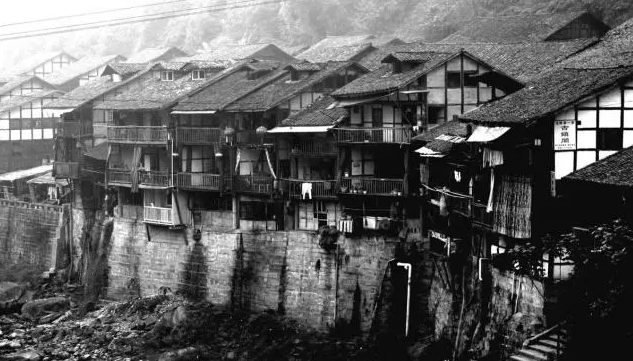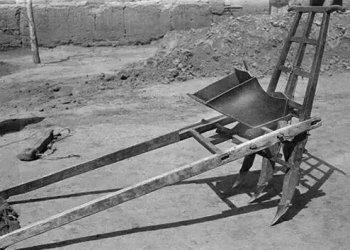In 1981, the stilted houses along the banks of the Jialing River in Chongqing were a common sight. These houses, prevalent throughout the city’s riverbanks, are now all but gone. The stilted houses in ancient towns like Bianyan in Beibei, Zhongshan in Jiangjin, and Kong in Rongchang, although distinct from those in central Chongqing, are also disappearing.
To understand the significance of these stilted houses, one must first delve into their history and the stories they tell. One such story recounts the time before the famous scholar Li Diaoyuan of Sichuan passed his imperial examination and became a top scholar. One day, Li visited a small rural market where there stood an overpass building with a restaurant beneath. Drunk from several bowls of wine, Li began to sing and compose poetry. The innkeeper, recognizing the scholar, decided to challenge him, saying, “I’ll give you a couplet. If you can answer correctly, your bill is on the house. If not, you’ll pay double. What do you say?” Li agreed, and the innkeeper presented the first line: “A store at the crossroads with no exit.”

Li struggled to find an answer and, unable to respond, prepared to pay for the drinks. As he stepped out of the shop and gazed upon a stilted house perched high on the cliffs by the river, the gentle breeze blew and his mind cleared. He immediately responded, “A stilted house on three sides facing the river.” Upon looking back at the store, he sighed and accepted his defeat.
The stilted house is a common form of housing in the south ern mountainous regions of China, particularly in Chongqing, southern Sichuan, western Hunan, and western Hubei. Despite their seemingly precarious and unstable appearance, with their tilted posts and swaying structure, stilted houses are surprisingly resilient. Even during earthquakes, they may sway, but they don’t collapse. During floods, the rising muddy waters might wash over their feet, but the stilted houses remain standing, making creaking sounds as they sway, only to see the waters recede once more.
What is most astonishing is that these houses have withstood the test of time, even in the face of natural disasters. Such resilience often leaves outsiders in awe, wondering how these seemingly fragile structures endure. The history of the stilted house can be traced back to the legendary “Hou Chao Shi” (Ancestor of the Nest), a mythical ancestor of the Chinese people.
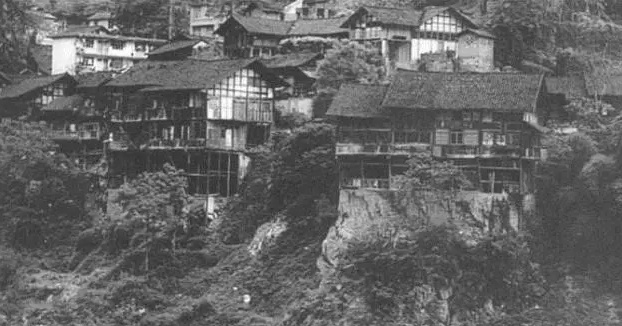
Stilted houses have roots that can be traced back thousands of years, with evidence dating to the late Neolithic period. In the semi-arid regions of northern China, early dwellings were built with natural materials such as reeds and grass, while in the humid southern regions, residents adapted by raising their homes off the ground to avoid moisture and pests. The technique of building stilted homes can be seen in the artifacts of the Hemudu culture in Zhejiang and the Banpo culture near Xi’an, where circular structures were supported by wooden posts and straw roofs.
It’s believed that the Ba people of ancient China, descendants of the Yue people, carried on the tradition of building stilted houses, or “ganlan” homes. Ancient texts such as The New Tang Book describe the southern region’s unique “ganlan” style housing as an adaptation to the wet environment, elevating their homes to avoid moisture and pests. The Ba people, who inhabited regions such as modern-day Chongqing, were known for their rock tombs and nest-like dwellings, setting them apart from their northern counterparts.
Chongqing’s stilted houses have a distinct character. These houses are often built on cliffs, using the steep terrain to their advantage. While some of these homes have vertical support beams, many houses are supported at an angle, creating a “twisted foot” structure, where the stilted support leans against the cliffside at an almost 45-degree angle. This unique design, known as “guaijiao” or “twisted foot,” allows for greater stability on the steep slopes of the mountains.
This architectural style can be found in the areas along the rivers in Chongqing, where the stilted houses line the banks like a breathtaking landscape. These houses are not only functional but also serve as a visual symbol of Chongqing’s deep connection with the natural environment. The use of twisted foot structures maximizes the available land while ensuring the buildings are anchored securely against the cliff.
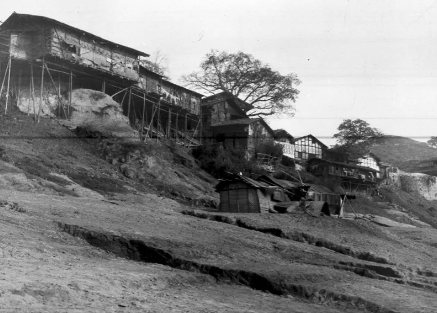
The construction of stilted houses is an intricate process that requires careful planning. The wood used in the construction is often pine or fir, selected for its durability and strength. The “foot” of the house, or the support structure, is angled to distribute weight effectively, making the entire structure more resilient against external forces. In many cases, the houses are tied together, with neighboring buildings reinforcing one another’s stability.
The materials used in stilted house construction also vary depending on the region. In Chongqing, houses are often built using bamboo and thin wooden beams, while in other regions, fir wood and steel are used. However, the most notable feature of these homes is the use of “binding” techniques, where the wooden beams are tied together with bamboo or steel wire, securing the frame of the house without the need for nails or pegs.
While the structure itself is quite durable, the maintenance of the houses presents a challenge. Over time, the bamboo or wire used for binding deteriorates, and the wooden beams may begin to crack. This requires constant upkeep to ensure the safety and longevity of the home. The roofs are often tiled with clay, but the construction of the roofs can be dangerous, as the steep slope and the elevated height make it difficult to secure the tiles properly. Strong winds or heavy rains can dislodge the tiles, causing leaks inside the house.
In recent decades, the stilted houses of Chongqing have largely disappeared. The houses, which once lined the city’s riverbanks, have been replaced by modern, concrete buildings. While the stilted houses served as a practical solution for living in the challenging mountainous terrain, they are no longer suitable for modern needs. The narrow, dark alleyways, the damp environment, and the fire hazards posed by the wooden structure make them less ideal for contemporary living.
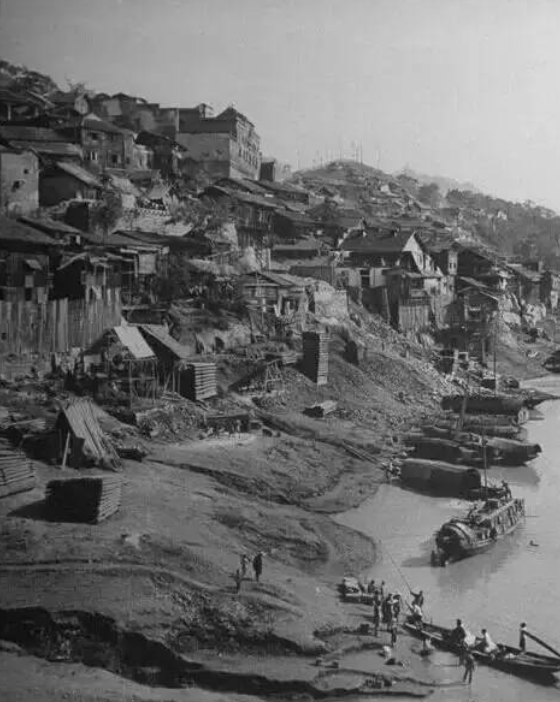
The demolition of these stilted houses has led to a sense of loss among many residents, who remember the charm and character of these traditional homes. Despite their drawbacks, stilted houses were an integral part of Chongqing’s cultural identity and the history of the region.
Today, the stilted houses of Chongqing have become a symbol of the city’s historical heritage, reflecting the ingenuity and resilience of the people who lived in them. Though they are no longer a common sight, their legacy continues to live on in the memories of those who grew up in these unique homes.
The stilted houses of Chongqing, with their distinct architectural style and history, represent a unique adaptation to the environment. Although these houses are now disappearing, they remain an important part of the cultural and historical fabric of the region. They embody the resilience and resourcefulness of the people who built them, and their legacy serves as a reminder of the ways in which traditional architecture can reflect the relationship between people and the land they inhabit.
The disappearance of the stilted house marks the end of an era, but it also underscores the importance of preserving cultural heritage. As time moves forward, the memory of these homes will live on, a testament to the ingenuity and strength of the people of Chongqing.
